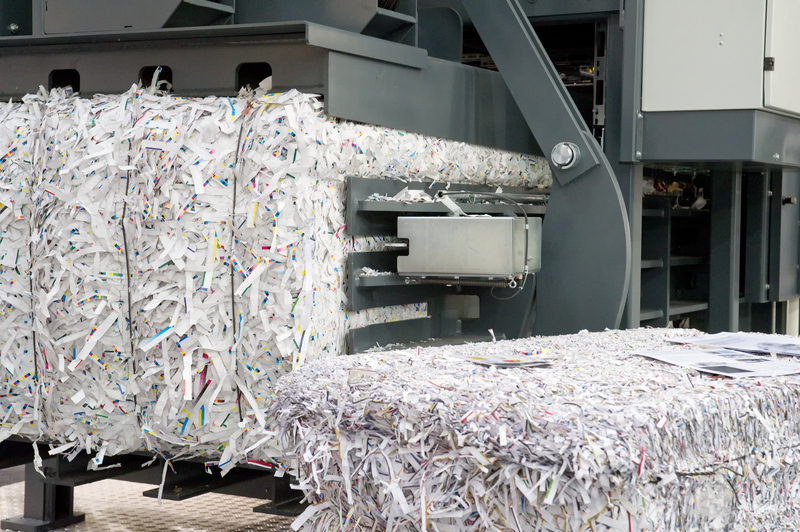Lead Your Team to Better Recycling Habits at Work
In today's environmentally-conscious world, the pressure is on organizations to adopt sustainable practices--not just for regulatory compliance, but to affirm their commitment to making a positive impact. For many businesses, developing effective workplace recycling habits is the perfect place to start. Whether your organization has a recycling program or is looking to launch one, empowering your team can deliver measurable environmental--and business--benefits.

Why Foster Better Recycling Habits at Work?
Building a culture of responsible recycling at the office is more important than ever. Employees are looking to their employers to lead the way in sustainability, and customers increasingly reward companies that can demonstrate concrete green initiatives. But the benefits go much further than public perception:
- Reduces operational costs by diverting waste from landfills and lowering disposal fees.
- Helps your organization meet sustainability goals and regulatory requirements.
- Enhances team engagement as employees rally around a shared purpose.
- Preserves natural resources and reduces the business's carbon footprint.
- Builds your brand's reputation with eco-friendly practices.
If you want to lead your team to better recycling habits at work, strategic planning and buy-in at all levels are essential. Here's how to build a successful recycling culture from scratch or refine your current efforts for greater impact.
Assess Your Current Workplace Recycling System
The first step in creating an effective workplace recycling program is understanding your company's current state. Does your office recycle at all? If so, how well is the program used? If not, what are the major obstacles to recycling?
Conduct a Waste Audit
Start by taking stock of the types and amounts of waste your office generates. A waste audit involves collecting, sorting, and analyzing waste over a set period, helping you identify recyclables, contamination points, and materials often discarded improperly.
- Work with your cleaning staff or recycling vendor to observe disposal practices.
- Note how much compostable, recyclable, and non-recyclable waste is generated.
- Identify the biggest sources of contamination (for example: food in recycling bins).
Survey Your Employees
Engage your team directly by sending out a brief survey about recycling attitudes and practices. Ask questions such as:
- How often do you recycle at work?
- Are you confident you know what belongs in each recycling bin?
- What would make recycling easier at the office?
- Do you see any barriers to better recycling habits among colleagues?
This data will pinpoint areas for targeted improvements and help you tailor your efforts to your team's needs.
Design a User-Friendly Recycling Program
Once you understand the challenges and opportunities, it's time to create a recycling system that's easy and intuitive for everyone to use. Here's how to set your team up for success:
Strategically Place Recycling Bins
The best recycling programs are only as effective as they are accessible. Place bins where recyclable material is commonly used:
- Next to printers/copiers for paper recycling.
- In kitchens and break rooms for cans, bottles, and compost.
- At employees' desks or workstations for paper waste.
- In meeting rooms for convenience during gatherings and events.
Pair recycling bins with landfill (general waste) bins to avoid "wish-cycling" (putting non-recyclables in the recycling bin) and reduce contamination.
Label Bins with Clear, Visual Instructions
Confusion over what belongs in each bin is the number one cause of contamination. Make bin signages simple and visual: use images alongside text, bold colors, and language that is easy to read at a glance.
- Use universally recognized recycling symbols.
- Display "YES" and "NO" lists at each bin.
- Highlight the most common mistakes (e.g., "No coffee cups" in paper recycling).
Provide Recycling Stations for Difficult Items
Set up specialized collection points for items that need special recycling streams, such as:
- Batteries
- Electronics (e-waste)
- Ink cartridges and printer toners
- Plastic films and soft plastics
Partner with certified recycling companies for these materials to ensure ethical and responsible disposal.
Inspire, Motivate, and Educate Your Office Team
A successful office recycling initiative requires more than just bins--it depends on team engagement, ongoing education, and a sense of collective ownership. Here are powerful strategies to lead by example and drive organization-wide participation:
Launch with a Kick-Off Event
Create buzz and excitement around your updated recycling program by hosting an all-staff event. During the launch:
- Showcase the sustainability goals of your organization.
- Demonstrate how to use the new recycling stations and how they work.
- Invite local recycling experts for a short presentation or Q&A.
- Hand out recycling guides or infographics everyone can keep at their desks.
Provide Ongoing Training and Refreshers
People retain new information better when it's reinforced over time. Offer regular training sessions, share updated recycling best practices, and use email newsletters or posters to remind staff of key rules and updates. Incorporate:
- Lunch-and-learn events about local recycling facilities.
- Short quizzes or friendly competitions that reinforce recycling know-how.
- Visual reminders near break rooms and printers.
Empower Recycling Champions
Identify volunteers or "green team" members in each department who can act as recycling ambassadors. Their mission is to:
- Lead by example in correct recycling practices.
- Answer colleagues' questions and clear up confusion.
- Report contamination issues or supply shortages.
- Motivate others and foster a spirit of friendly accountability.
Track Progress and Celebrate Successes
Make sure your recycling initiative doesn't fizzle out by setting measurable targets and tracking performance over time. Monitoring progress helps maintain momentum and motivates employees to stick with better recycling habits at work.
Set Clear, Achievable Goals
- Reduce landfill waste by a certain percentage within 12 months.
- Increase the office recycling rate week by week or quarter by quarter.
- Achieve zero contamination in recycling bins for a set period.
Measure and Report Performance
Work with your waste management provider to get weight or volume reports. Share results regularly:
- Post progress updates on your company's intranet or in-office notice boards.
- Hold team meetings to review achievements and recognize star recyclers.
- Celebrate major milestones with eco-friendly rewards (like reusable mugs, water bottles, or an office plant).
Solicit Feedback and Stay Agile
Encourage the team to share feedback about the recycling program. Are there new challenges? Unexpected obstacles? Stay responsive and adapt your approach to guarantee long-term success.
Overcoming Common Challenges to Better Office Recycling
Even with the best plans, you may face resistance or logistical challenges as you lead your team to better recycling habits at work. Here's how to tackle some of the most frequent hurdles:
Lack of Awareness or Misunderstandings
Solution: Host regular refresher courses and make guides easily accessible. Try creative reminders such as fun facts posted near bins or quick "myth-busting" emails.
Contaminated Bins
Contamination is typically the result of "wish-cycling" (putting non-recyclables in recycling bins) or lack of information.
Solution: Clarify rules with visuals and check bins regularly. Announce contamination rates and encourage employees to double check before tossing items.
Low Participation Rates
Solution: Motivate teams with friendly competitions or recognition. Share real-world impact stories--for example, how many trees your paper recycling saves, or how much landfill space your office has avoided.
No Collection for Certain Materials
Solution: Partner with specialized recycling vendors or local drop-off programs for batteries, e-waste, and other hard-to-process materials.
"It's Not My Job" Mentality
Solution: Make sustainability part of everyone's responsibility by tying recycling participation to company values, or including it in job expectations and onboarding for new hires.
Advanced Steps: Take Recycling to the Next Level
Already have recycling systems in place? Here are suggestions to help your team lead in workplace recycling innovation:
- Start an office composting program for food waste.
- Host a "zero-waste" challenge week, encouraging employees to minimize disposables.
- Set up refill stations for soap, coffee, or snacks to reduce packaging.
- Switch to digital processes to cut down on paper (e.g., paperless meetings).
- Source recycled or upcycled office supplies and furniture.
- Share your success stories externally via company blogs or press releases to build your brand as an environmental leader.

The Role of Leadership: Why Managers Matter
No recycling program thrives without visible, enthusiastic support from managers and executives. When leaders model strong office recycling habits, employees are more likely to follow suit.
Tips for Leaders:
- Be an early adopter: sort your waste correctly and encourage team members personally.
- Include recycling updates in team meetings and performance reviews.
- Allocate budget for new bins, posters, or incentives.
- Encourage cross-department participation for organization-wide impact.
Conclusion: Empower Your Team, Transform Your Workplace
Leading your team to better recycling habits at work isn't just about putting bins in every room. It's about inspiring shared responsibility, providing the right tools and education, and continually motivating your team to take small but impactful steps. With thoughtful planning, genuine enthusiasm, and clear communication, your workplace can become a true model of environmental stewardship--and make a notable difference for the planet.
Start building better office recycling habits with your team today, and watch as workplace sustainability grows, engagement soars, and your organization's commitment to green values shines both inside and out.